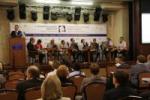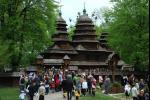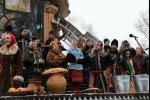- عربي
- Ukraine
- Economy
-
Investment
- Current Investment Trends
- Legal Conditions of Doing Business
- Investment Policy
- Competition
- Setting a Business in Ukraine
- Mergers and Acquisitions
- Taxation
- Import and Export
- Banks and Bank Regulation
- Convertibility and Profits Repatriation
- Currency Regulation
- Protection of Intellectual Property Rights
- Companies
- Travel to Ukraine
- About us
- Useful Sites
- Gallery
- News
Currency rates in UAH
| AED | ||
| BHD | ||
| EGP | ||
| KWD | ||
| LBP | ||
| OMR | ||
| QAR | ||
| SAR | ||
| SYP |
2015-07-06
| Kiev |  |
+32 |
| Donetsk |  |
+28 |
| Dnipropetrovsk |  |
+31 |
| Lviv |  |
+31 |
| Odessa |  |
+27 |
Strengthening of the Soviet System
The end of the military events was not the sign for changing policy based on the communist doctrine. On the contrary, the program of restoration and development of industry according to the GOELRO plan was to be realized with the help of a surplus-appropriation system (i.e., forced state tasks for sowing and delivering agriculture products).
In the winter of 1920-1921 there was a mass uprising of Ukrainian peasants against the Soviet power which S. Petliura had expected in spring of 1920 when he was in the offensive with the Poles against Kyiv. Possessed peasants rioe against the trade prohibition and surplus-appropriation system. Most efficient units of the Red Army, headed by V. Bliukher, H. Kotovskyi, O. Parkhomenko, were sent to struggle with the peasants’ detachments. The army itself also mainly consisted of peasants and thus became less and less reliable.
In the spring of 1921, V. Lenin had to refuse from the surplus-appropriation system and to renew free trade. New Economic Policy (NEP) replaced the old communist one. The transition to NEP proceeded painfully and under pressure of evident realities of the economic life.
The introduction of NEP in
The legalization of private trade and currency reform of 1922-1924 drew the enterprises from underground. New bourgeoisie (tenants, wholesalers, industrialists, commission agents, and brokers) appeared in the country. They quickly saved the country from economic chaos, but the authorities disapproved of them. Lenin emphasized that NEP is a forced and temporary retreat from fulfilling the communist program.
The
Lenin’s proposition was realized and not even Josef Stalin opposed the proposition. And it was not a coincidence since the dictatorship of the party, which turned the
A separate political bureau was created inside the Central Committee in
In December 1925, three years after the
In 1927, the 15th Congress of VCP(b) adopted directives of making the first five-year plan of development of the national economy for 1928/1929 to 1932/1933, which included a principal decision for complete use of this method of confiscation of peasants’ incomes. The peasants did not want to sell their products for low prices. The crises in state grain procurements took place in 1927-1929.
In the previous years they used the market method for finding a way out of this kind of situation by raising prices for bread. In 1928, Josef Stalin separated peasants from the market and deprived them of the means of production and prohibited free trade. In November 1919, the decision to collectivize agriculture was made. In order to prevent resistance to expropriation of peasants’ property, the state opposed the owners and proletarized strata of the village population. Rich peasants (or kurkuli) who strongly resisted collectivization were expropriated or deported. When peasants refused forced labor Stalin’s response was famine. The results were terrible, and 3.5 million people starved to death in Soviet Ukraine. Total losses, including the decrease in the birth rate, reached close to 5 million. Approximately one million people perished in the
Cultural construction was a constituent of socio-economic transformation in the period between the First and Second World War. The maintenance of the cultural forms of the national movement under the ruthless struggle with its state forms as well as the emphasis on raising the culture, were the main features of policy of the state party in the sphere of culture. The liquidation of illiteracy, introduction of general compulsory education, preference for workers when applying to institutions of higher learning were all among the important trends of cultural construction.
Religion composed an important part of the intellectual culture of people. However, the communist party wanted to annihilate the church, because it was the only element of pre-revolutionary social structure that still existed and replace it with an atheistic consciousness. Religious music, literature, philosophy and even church architecture were annihilated. One could not find an Orthodox bishop in
In 1935, Stalin decided to announce the victory of socialism and introduced changes to the constitution directed at democratizing the election system - replacing unequal elections with equal ones, and open elections with secret ones. The constitution of the
The outward democratization of power was accompanied by political repression, which began developing after the murder of



